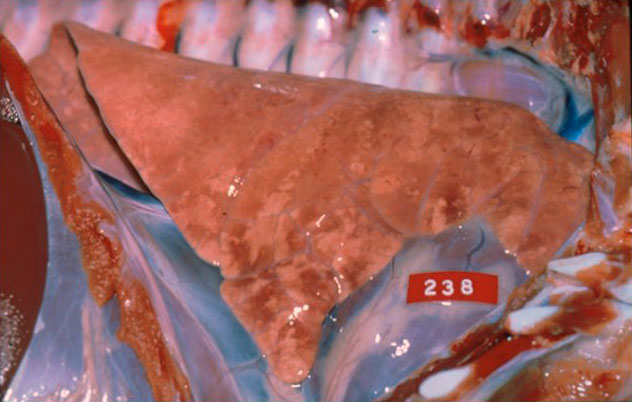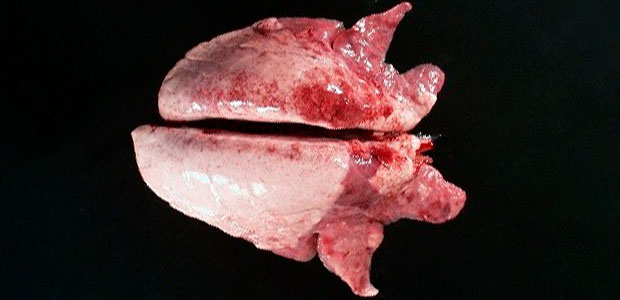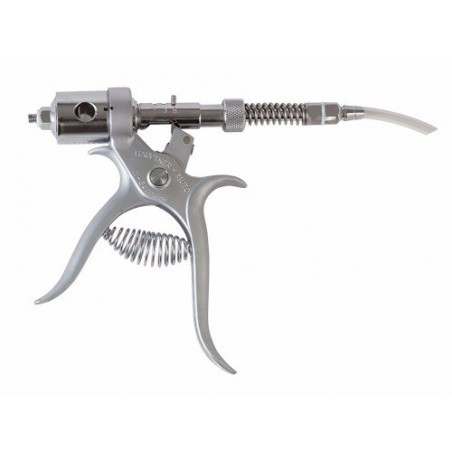Why do pigs cough? Coughing is a response when the nerve endings along the lining of the respiratory tract become irritated, such as by contact with an infectious agent or with dust in the air. But not all coughs are the same, so there are various possible explanations for the process behind them.
The time spent in a barn just listening to the coughs can give an early clue to the background of troubles with the porcine respiratory disease complex (PRDC). PRDC causes respiratory distress and productivity losses in at least 30% of pigs in affected herds. It can be the result of a single pathogen, but mainly caused by multiple infections working with environmental stressors.

Table 1: Primary and secondary pathogens involved in PRDC.
| PRIMARY PATHOGENS | SECONDARY PATHOGENS |
|---|---|
| Influenza A virus in Swine (IAVS) | PCV2 |
| PRRS virus | Pasteurella multocida |
| Mycoplasma hyopneumoniae (Mhp) | Haemophilus parasuis |
| Actinobacillus pleuropneumoniae (App)* | Bordetella bronchispectica |
| Actinobacillus suis* | Streptococcus suis |
| Aujeszky’s Disease/Pseudorabies virus (PRV) |
Arcanobacterium (Actinomyces) pyogenes |
| Classical Swine Fever virus | |
| Septicemic bacteria |
*May also act as a secondary pathogen
Source: Dr. G. Stevenson (personal communication)
PRDC Symptoms depend on the pigs’ age as well as on the characteristics of the infectious agent/s. Differences occur in the sound of the coughing and in how rapidly the pigs cough, over time in a barn. Both of these factors help us to recognise what is happening to their health.
While counting coughs is now widely accepted to be a useful aid to the determination of respiratory disease on a growing and finishing pig unit, therefore, it seems that there is added information in the actual sound of the cough.
Coughs differ in sound because of differences in the mechanisms behind them. A close connection between the kind of cough heard in the barn and the necropsy evidence of the damage to airways created by a particular respiratory infection can be described.
Differentiating infections: From a honking goose to a smoker’s cough
Out of the possible culprits as an infectious cause of coughing in pigs, prominent among them is the Influenza A virus in Swine (IAVS). IAVS’s cough has the sound of a honking goose and occurs in fits or paroxysms. It results from an invasion by the virus into cells lining the airways. The cells die, leaving a raw tract in which nerve endings are exposed. This gives a painful tickling of the throat that generates an explosive cough, which itself starts more coughing by the same animal.
By comparison, an infection with the PRRS virus produces a moist, rather high-pitched cough because the presence of the virus inside alveolar macrophages prompts an inflammatory response in which fluid from the blood can enter the air spaces of the lung. At its worst, this effect threatens to kill the pig as if by drowning. More often the infected animals will cough to clear their lungs over several days, although animals hit by PRRS tend not to cough as harshly as with IAVS, example, nor to suffer the frequent and persistent bouts of coughing that Mycoplasma hyopneumoniae (Mhp) can trigger.
Many producers and veterinarians will recognise the dry, non-productive cough due to Mhp. It arises after the bacteria colonise and damage the cilia along the respiratory tract. Cilia given a blunted shape by Mhp colonisation work less well at carrying mucus up to the throat. This mucus instead builds up at spots in the airway, prompting the pig to cough to clear it. The coughing due to Mhp is noticeable not just because of its persistence. It has the distinctive sound of a smoker’s cough --- dry, ending sometimes with a gagging on mucus in the throat --- that erupts all through the barn soon after the pigs become active. Then when the pigs settle once more, the coughing continues although at a reduced frequency.
A sharp cough can accompany acute clinical disease due to Actinobacillus pleuropneumoniae (App), but spontaneous fits of coughing are more characteristic of the chronic form which follows an acute episode in pigs that survive. If App carried in the pigs’ tonsils are able to reach the alveoli of the lungs, they multiply and release toxins capable of producing pneumonia and necrotic and haemorrhagic lesions. The moist coughing is an attempt by the animal to breathe more easily by evicting fluid or exudate.
Prevalence and frequency
Episodes of coughing pigs have other points of difference regarding their prevalence (number of pigs affected in a population) and their frequency (how often the pigs cough). With uncomplicated PRRS, for example, there tends to be a moderately rapid increase in the prevalence of coughing although the cough itself typically remains infrequent to periodic.
Compare this with the extremely rapid rise in prevalence found with IAVS, for which the stimulus to cough is ever-present so that the frequency of coughing is high. As for Mhp, any increase in prevalence is slow and the coughing is rather infrequent until secondary bacteria become involved.
However, Mhp often is a door-opener to more serious disease when the involvement of the secondaries creates a purulent form of broncho-pneumonia. Then the formerly dry cough sounds more moist and frequency rises.
Frequency reflects the transmissibility of a pathogen. There is a clear contrast here between IAVS and Mhp. IAVS spreads rapidly so that one animal shedding the virus will typically transmit it to every other pig in a 30-pig pen within 4-5 days. Mhp is slow by comparison --- within a similar pen, it will have transmitted to only 1-2 other pigs even after 30 days.
Post-slaughter evidence also differs
While the influenza agent may have been present only for 7-10 days, it leaves behind severe lesions that remain detectable long after the virus itself has gone. Those lesions do not affect all lobules of the lung, instead leaving a chequerboard pattern in the tissues in which the purple-coloured areas are the ones affected. PRRS by contrast produces lesions across the whole lung. However, both viruses share a tendency for their lesions to have disappeared or become less obvious by the time the infected pigs have reached slaughter. Mhp is different in that its lesions are more likely to be seen in the abattoir, although in fact the damage could be quite recent and did not account for any coughing heard in the growing period.


Just as commonly, though, an Mhp colonisation of the lungs has only sub-clinical consequences. Therefore, conclusions should only be drawn after a careful evaluation. Just finding Mhp does not imply that the organism was the cause of the coughing or other signs of clinical respiratory disease.







